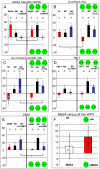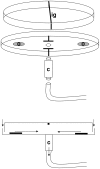Complex odor from plants under attack: herbivore's enemies react to the whole, not its parts
- PMID: 21765908
- PMCID: PMC3135591
- DOI: 10.1371/journal.pone.0021742
Complex odor from plants under attack: herbivore's enemies react to the whole, not its parts
Abstract
Background: Insect herbivory induces plant odors that attract herbivores' natural enemies. Assuming this attraction emerges from individual compounds, genetic control over odor emission of crops may provide a rationale for manipulating the distribution of predators used for pest control. However, studies on odor perception in vertebrates and invertebrates suggest that olfactory information processing of mixtures results in odor percepts that are a synthetic whole and not a set of components that could function as recognizable individual attractants. Here, we ask if predators respond to herbivore-induced attractants in odor mixtures or to odor mixture as a whole.
Methodology/principal findings: We studied a system consisting of Lima bean, the herbivorous mite Tetranychus urticae and the predatory mite Phytoseiulus persimilis. We found that four herbivore-induced bean volatiles are not attractive in pure form while a fifth, methyl salicylate (MeSA), is. Several reduced mixtures deficient in one component compared to the full spider-mite induced blend were not attractive despite the presence of MeSA indicating that the predators cannot detect this component in these odor mixtures. A mixture of all five HIPV is most attractive, when offered together with the non-induced odor of Lima bean. Odors that elicit no response in their pure form were essential components of the attractive mixture.
Conclusions/significance: We conclude that the predatory mites perceive odors as a synthetic whole and that the hypothesis that predatory mites recognize attractive HIPV in odor mixtures is unsupported.
Conflict of interest statement
Figures



Similar articles
-
Predatory mite attraction to herbivore-induced plant odors is not a consequence of attraction to individual herbivore-induced plant volatiles.J Chem Ecol. 2008 Jun;34(6):791-803. doi: 10.1007/s10886-008-9492-5. Epub 2008 Jun 3. J Chem Ecol. 2008. PMID: 18521678 Free PMC article.
-
The predatory mite Phytoseiulus persimilis does not perceive odor mixtures as strictly elemental objects.J Chem Ecol. 2010 Nov;36(11):1211-25. doi: 10.1007/s10886-010-9858-3. Epub 2010 Sep 25. J Chem Ecol. 2010. PMID: 20872172 Free PMC article.
-
Response of predatory mites to a herbivore-induced plant volatile: genetic variation for context-dependent behaviour.J Chem Ecol. 2010 Jul;36(7):680-8. doi: 10.1007/s10886-010-9818-y. Epub 2010 Jun 25. J Chem Ecol. 2010. PMID: 20574785 Free PMC article.
-
The specificity of herbivore-induced plant volatiles in attracting herbivore enemies.Trends Plant Sci. 2012 May;17(5):303-10. doi: 10.1016/j.tplants.2012.03.012. Epub 2012 Apr 12. Trends Plant Sci. 2012. PMID: 22503606 Review.
-
Plant-Herbivore Interactions: A Case of an Extreme Generalist, the Two-Spotted Spider Mite Tetranychus urticae.Mol Plant Microbe Interact. 2017 Dec;30(12):935-945. doi: 10.1094/MPMI-07-17-0168-CR. Epub 2017 Oct 23. Mol Plant Microbe Interact. 2017. PMID: 28857675 Review.
Cited by
-
Canopy light cues affect emission of constitutive and methyl jasmonate-induced volatile organic compounds in Arabidopsis thaliana.New Phytol. 2013 Nov;200(3):861-874. doi: 10.1111/nph.12407. Epub 2013 Jul 12. New Phytol. 2013. PMID: 23845065 Free PMC article.
-
The predatory mite Typhlodromalus aripo prefers green-mite induced plant odours from pubescent cassava varieties.Exp Appl Acarol. 2012 Dec;58(4):359-70. doi: 10.1007/s10493-012-9595-0. Epub 2012 Jun 29. Exp Appl Acarol. 2012. PMID: 22744197 Free PMC article.
-
Effects of Abiotic Factors on HIPV-Mediated Interactions between Plants and Parasitoids.Biomed Res Int. 2015;2015:342982. doi: 10.1155/2015/342982. Epub 2015 Dec 15. Biomed Res Int. 2015. PMID: 26788501 Free PMC article. Review.
-
Testing for phytochemical synergism: arthropod community responses to induced plant volatile blends across crops.J Chem Ecol. 2012 Oct;38(10):1264-75. doi: 10.1007/s10886-012-0202-y. Epub 2012 Oct 23. J Chem Ecol. 2012. PMID: 23090849
-
Attractant Activity of Host-Related Chemical Blends on the Poultry Red Mite at Different Spatial Scales.J Chem Ecol. 2023 Feb;49(1-2):18-35. doi: 10.1007/s10886-022-01399-7. Epub 2022 Dec 19. J Chem Ecol. 2023. PMID: 36534242
References
-
- El-Sayed AM. 2011. Pherobase: Database of insect pheromones and semiochemicals ( http://www.pherobase.com). Accessed 2011 Jun 22.
-
- Kappers IF, Aharoni A, van Herpen T, Luckerhoff LLP, Dicke M, et al. Genetic engineering of terpenoid metabolism attracts, bodyguards to Arabidopsis. Science. 2005;309:2070–2072. - PubMed
-
- Laurent G, Stopfer M, Friedrich RW, Rabinovich MI, Volkovskii A, et al. Odor encoding as an active, dynamical process: Experiments, computation, and theory. Annual Review of Neuroscience. 2001;24:263–297. - PubMed
-
- Lledo PM, Gheusi G, Vincent JD. Information processing in the mammalian olfactory system. Physiological Reviews. 2005;85:281–317. - PubMed
-
- Webster B, Bruce T, Pickett J, Hardie J. Volatiles functioning as host cues in a blend become nonhost cues when presented alone to the black bean aphid. Animal Behaviour. 2010;79:451–457.
Publication types
MeSH terms
Substances
LinkOut - more resources
Full Text Sources

